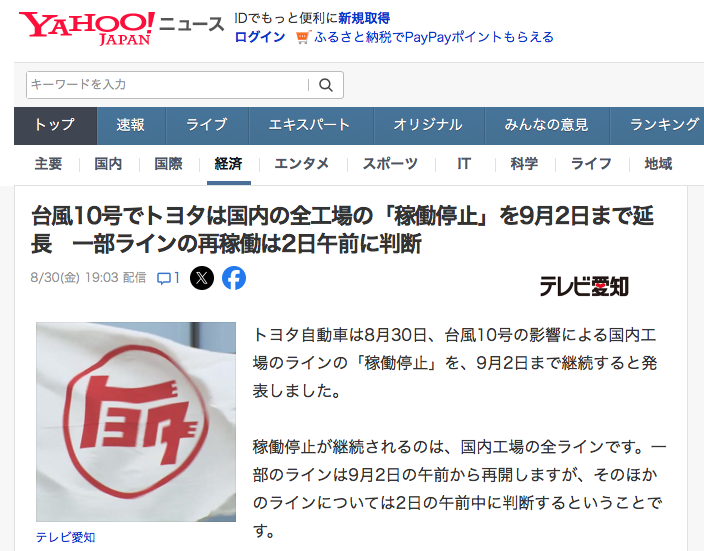According to reports from multiple media outlets such as NHK, affected by Typhoon Shanshan, the No. 10 typhoon this year, a total of 28 production lines in 14 factories of Japanese automaker Toyota within Japan will continue to suspend production until the morning of September 2. Whether to resume work in the afternoon of September 2 will be determined on that day. Previously on August 28, Toyota announced that all its factories in Japan were temporarily shut down, and the expected suspension period was from the evening of that day to the morning of the 29th. Besides Toyota, Honda has also temporarily closed its factory in Kumamoto in southwestern Kyushu. Nissan’s Kyushu factory was also shut down on Thursday and Friday this week, while Mazda suspended the operation of its factories in Hiroshima and Hofu, Yamaguchi Prefecture in western Japan from Thursday evening. According to reports from NHK Television, Super Typhoon Shanshan made landfall in the Kyushu region of Japan on the 29th and triggered heavy rain in the southern part of the country, resulting in at least 6 deaths and over 120 injuries in Japan. On the evening of August 30, the typhoon weakened into a tropical depression, and its wind strength is currently further weakening. This production suspension means that all of Toyota’s factories in the Japanese domestic market have completely suspended operations. This is also the first time since August 2023 that Toyota has suspended the operation of all its factories in Japan. On the morning of August 29, 2023, due to a system failure, a total of 12 out of 14 vehicle assembly plants of Toyota in Japan were temporarily suspended, involving 25 production lines. Starting from the afternoon of the same day, the suspension would expand to all 14 vehicle assembly plants, totaling 28 production lines. Operations resumed on August 30, but the brief suspension ultimately led to a production reduction of approximately 14,000 new vehicles. It is understood that domestic factories in Japan account for approximately one-third of Toyota’s annual production. As of the time of publication, it is not yet clear whether Toyota’s factories in the Japanese domestic market will be able to resume production in the afternoon of September 2, nor is it clear what kind of impact this production suspension will have on Toyota’s subsequent production capacity. On August 29, Toyota released its global production and sales data for July. In terms of production, the data shows that Toyota’s global production in July was 804,600 vehicles, a year-on-year decline of 0.6%, marking the sixth consecutive month of production decline for Toyota. In the细分 markets, Toyota’s production in the Japanese domestic market slightly increased by 0.1% to 309,100 vehicles, mainly benefiting from the resumed production of the Toyota Prius in the Japanese market. Additionally, the North American and European markets increased by 6.2% and 3.4% respectively. In contrast, Toyota’s production in China declined by 9.6%. In terms of sales, Toyota’s global sales in July were 858,000 vehicles, a year-on-year decline of 0.2%. Analyzing by major markets, Toyota’s sales in the Japanese domestic market were 140,300 vehicles, a year-on-year decline of 0.6%; overseas market sales were 717,600 vehicles, a year-on-year decline of 0.1%. Additionally, sales in the Chinese market were 143,400 vehicles, a year-on-year decline of 6.1%. Even though Toyota’s production and sales data were not ideal, Toyota still achieved record highs in revenue and operating profit in the second quarter from April to June this year (the first quarter of fiscal year 2025). Among them, Toyota’s global revenue was 11.84 trillion yen (approximately 73.6 billion US dollars), a year-on-year increase of 12.2%; operating profit was 1.31 trillion yen (approximately 8.15 billion US dollars), a year-on-year increase of 17%; net profit was 1.33 trillion yen (approximately 8.27 billion US dollars), a year-on-year increase of 1.7%. Previously, it was reported that Toyota had revised down its global vehicle production plan for fiscal year 2024 from the original 10.3 million units to 9.8 million units, the first time in four years to be below 10 million units. Among them, production in the Japanese domestic market was 3.2 million units, and overseas production was 6.6 million units. Industry insiders believe that Toyota’s production reduction reflects the pressure it faces in the global market, especially in the Chinese market. With the rapid rise of Chinese independent brands, Toyota is generally under pressure in China. Data shows that in the first seven months of this year, Toyota’s sales in China showed a significant decline, with a year-on-year drop of 10.1% to 928,100 vehicles. As Toyota’s most important market globally, the decline in sales in the Chinese market has also put overall pressure on Toyota’s global sales. What kind of impact the complete factory suspension of Toyota due to Typhoon Shanshan will cause, “Auto Industry Focus” will continue to follow up in the future.
Affected by the typhoon! All Toyota factories in Japan have suspended production.

